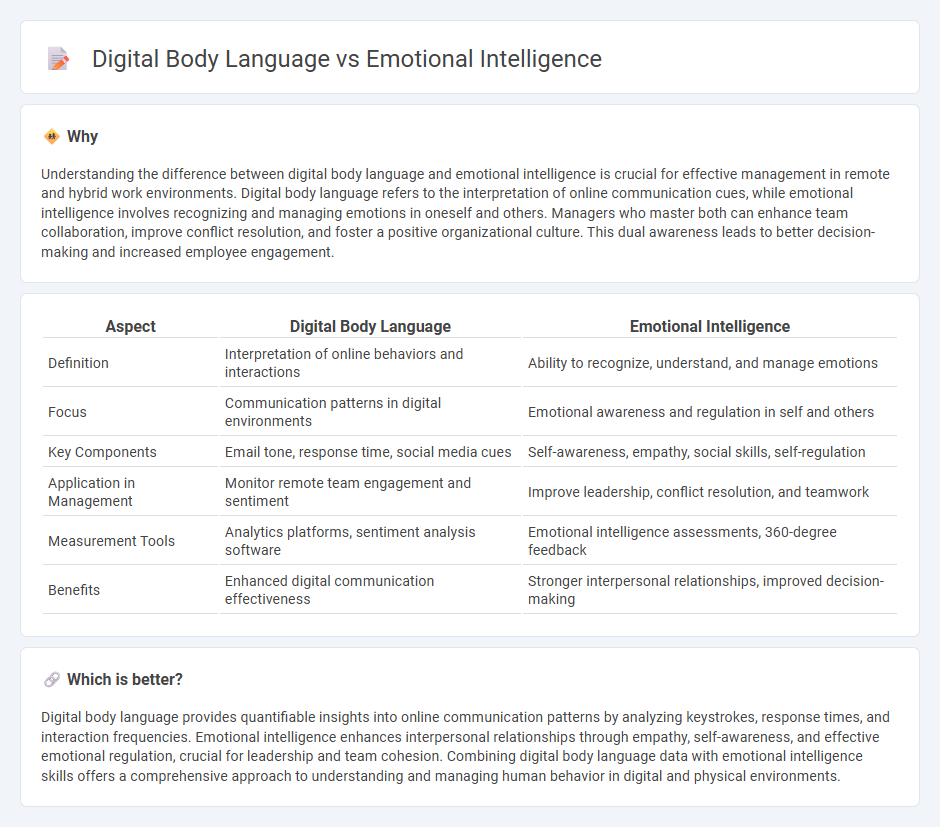
Digital body language reveals how individuals communicate through online cues such as typing speed, emoji use, and response times, shaping workplace interactions in virtual environments. Emotional intelligence encompasses the ability to recognize, understand, and manage one's own emotions and those of others, fostering effective interpersonal relationships and leadership. Explore the interplay between digital signals and emotional insight to enhance management strategies in today's digital landscape.
Why it is important
Understanding the difference between digital body language and emotional intelligence is crucial for effective management in remote and hybrid work environments. Digital body language refers to the interpretation of online communication cues, while emotional intelligence involves recognizing and managing emotions in oneself and others. Managers who master both can enhance team collaboration, improve conflict resolution, and foster a positive organizational culture. This dual awareness leads to better decision-making and increased employee engagement.
Comparison Table
| Aspect | Digital Body Language | Emotional Intelligence |
|---|---|---|
| Definition | Interpretation of online behaviors and interactions | Ability to recognize, understand, and manage emotions |
| Focus | Communication patterns in digital environments | Emotional awareness and regulation in self and others |
| Key Components | Email tone, response time, social media cues | Self-awareness, empathy, social skills, self-regulation |
| Application in Management | Monitor remote team engagement and sentiment | Improve leadership, conflict resolution, and teamwork |
| Measurement Tools | Analytics platforms, sentiment analysis software | Emotional intelligence assessments, 360-degree feedback |
| Benefits | Enhanced digital communication effectiveness | Stronger interpersonal relationships, improved decision-making |
Which is better?
Digital body language provides quantifiable insights into online communication patterns by analyzing keystrokes, response times, and interaction frequencies. Emotional intelligence enhances interpersonal relationships through empathy, self-awareness, and effective emotional regulation, crucial for leadership and team cohesion. Combining digital body language data with emotional intelligence skills offers a comprehensive approach to understanding and managing human behavior in digital and physical environments.
Connection
Digital body language reveals subtle cues like typing speed, response time, and emoji use that reflect emotional states, enabling managers to interpret team members' feelings remotely. Emotional intelligence supports the accurate reading and response to these digital signals, fostering empathy and effective communication in virtual environments. Together, they enhance leadership by bridging the gap between digital interaction and human emotion for improved team dynamics.
Key Terms
Self-awareness
Self-awareness in emotional intelligence involves recognizing and understanding one's emotions, enabling better self-regulation and interpersonal interactions. Digital body language refers to interpreting cues such as tone, response times, and message content in virtual communication to gauge emotions and intentions. Explore how mastering both enhances personal and professional relationships in digital environments.
Empathy
Emotional intelligence encompasses the ability to recognize, understand, and manage one's own emotions while empathizing with others' feelings, which drives deeper interpersonal connections. Digital body language refers to the nonverbal cues communicated through online interactions, such as tone, response time, and emoji use, highlighting nuanced empathy in virtual environments. Exploring how empathy bridges emotional intelligence and digital body language reveals strategies for enhancing remote communication and relationship-building; discover more insights here.
Communication
Emotional intelligence enhances communication by enabling individuals to recognize and manage emotions effectively, fostering empathy and clear interpersonal interactions. Digital body language involves interpreting cues such as typing speed, response time, and emoji use to understand intent and sentiment in virtual communication. Explore deeper insights into how mastering both emotional intelligence and digital body language can transform your communication skills.
Source and External Links
Emotional intelligence - Wikipedia - Emotional intelligence (EI) is the ability to perceive, use, understand, manage, and handle emotions, involving emotional recognition, emotional literacy, and adapting emotions to environments, with models to measure it including trait and ability approaches.
Spotlight: What it means to be emotionally intelligent | It's Your Yale - Emotional intelligence is commonly defined by four attributes: self-management, self-awareness, social awareness, and relationship management, enabling clear thinking, stress management, and better decision-making.
What is emotional intelligence and how does it apply to the workplace? - Emotional intelligence involves five key elements: self-awareness, self-regulation, motivation, empathy, and social skills, which are important for interpersonal skills and effective teamwork in workplace settings.
 dowidth.com
dowidth.com